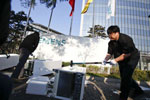Plan for safe medicines
Updated: 2011-12-09 08:37
(China Daily)
|
|||||||||||
It is not difficult to make a plan and set an objective. The real difficulty is ensuring the plan can be carried out in an effective manner. However inspiring a plan is, poor implementation means it will only render lip service to its aims.
The plan approved by the State Council on Wednesday is meant to plug loopholes in the monitoring and supervision of pharmaceutical companies so that all medicines meet the national standards by 2015.
The lack of a desirable credit rating system, inadequate supervision and weak technological support were cited by the State Council as the stumbling blocks that have to be overcome for the country's production and distribution of medicines to develop in a healthy manner.
As recent cases show, the lack of supervision and monitoring of licensed pharmaceutical plants is a big problem.
Some licensed pharmaceutical companies and plants were found to be involved in the largest ever case involving the production and sale of fake medicines - valued at 2.2 billion yuan ($345 million) - which was cracked last month.
In another case cracked by police in Shanghai, the recipe for the production of the fake medicine was found to come from a licensed pharmaceutical plant, and six chemical plants produced raw materials for the dealer.
But in addition to stricter supervision there needs to be stiffer penalties to deter people from becoming involved in the production of fake and low-quality medicines.
The problem is not only with pharmaceuticals. There have been deaths resulting from injections of medicinal herbs, which points to the lack of research and technology in upgrading the production of ready-made traditional Chinese medicines (TCM) including tablets, pills for oral use, and especially injections for intravenous use.
The new document from the State Council requires that efforts be made in the coming five years to make China the leader in the standards for TCM. That means more investment will have to be made in research to realize breakthroughs in upgrading TCM.
As far as pharmaceuticals are concerned, it is in their distribution and circulation where the middlemen make their profits by inflating prices, and it is here that the dealers in fake medicines can lubricate their way to hospitals and pharmacies.
Since the plan of the State Council makes it one of the major tasks to better regulate and streamline the distribution channels, thorough investigations are needed to find out where the problems lie, who gets the bulk of the profits from the considerably inflated drug prices and which links facilitate the circulation of fake medicines in the market.
The campaign initiated by some central government departments, including the Ministry of Public Security and State Food and Drug Administration, from 2009 to the first half of this year, has conducted thousands of investigations, and they may serve as a valuable reference for devising specific policies that will enable the new plan to be effectively implemented.




